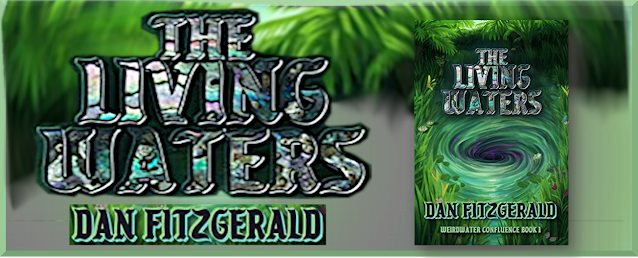The Living Waters by Dan Fitzgerald
When two painted-faced
nobles take a guided raft trip on a muddy river, they expect to rough it
for a few weeks before returning to their life of sheltered ease. But
when mysterious swirls start appearing in the water, even their seasoned
guides get rattled.
The mystery of the swirls lures them on to
the mythical wetlands known as the Living Waters. They discover a world
beyond their imagining, but stranger still are the worlds they find
inside their own minds as they are drawn deep into the troubles of this
hidden place.
The Living Waters is a sword-free fantasy novel
featuring an ethereal love story, meditation magic, and an ancient book
with cryptic marginalia. It is the first book in the Weirdwater
Confluence duology.
Okay, let’s get this out of the way, I loved this book!
There, said it! Job done!
You can all go home now!
Erm, erm, sorry! No, no, don’t go! I do have a few more things to say, but I hope you get the fact that I liked this book.
There’s a lot to admire in Dan Fitzgerald’s writing. I like how he is pushing the boundaries of fantasy to tell unconventional stories, which is always going to get my attention.
Now, I know that much has been said about the fact that this book does not contain a sharp pointy thing called a sword, and that makes no difference to the level of threat that is there in the story, except it comes from a different source than loads of fantasy peoples running around or threatening people with oversized cutlery.
The story centres around a raft trip down a river, and the events that happen on the trip.
Temi and Sylvan are two members of an aristocratic society who come from two ends of the specctrum. Sylavn is from a highly successful, well to do family, whilst Temi’s family are down on their luck and are hoping that the hue of Temi’s skin will bag her a rich, powerful husband in order to save the family’s fortunes.
The thing that these two have in common is that they are planning to take something called a Roughabout. A kind of trip that is designed to give the rich folk a bit of resilience and character. A sort of toffee nose rite of passage that lets the pampered, cosseted children of rich folk experience ‘real’ life.
Along with Temi and Sylvan is Leo, the organiser of the roughabout, and Gilea, Temi’s protector and aide.
Now whilst they all have one thing in common, they all have very different goals. Sylvan is a scholar of nature, particularly marine nature and biodiversity, and hopes to study the environment and compare what he finds to a work of scholarly art that he received for his graduation. Temi has her own plans that do not involve any of these things. Leo is in it for the money, but also some level of excitement and a hope to find The living Waters. Whilst Gilea is initially in it for the money, but finds that she has other motivations on the trip.
Essentially, I felt that it was a very gentle story about development and growth, and how experience affects each of differently. Each of the characters grow throughout the book in different ways and it was such a delight to see how each of the characters took different things away similar experiences and how they interpreted those experiences.
The book is a character driven book, and I got attached to all the characters in different ways. Temi and Sylvan are both nobles, and I found the construct of the upper eschelons quite fascinating. The nobles in The Living Waters paint their faces, and cherish their lightened skins as a way to denote their wealth and standing. Conversely, the regular folk of the country who work outside have sun browned skins that imply that these are commoners.
I adored each of the characters in the story, although I liked some more than others. I think most people will find Temi and Gilea’s arc the most satisfying, and I did enjoy their stories. Temi is strong willed , she becomes quite ill in the story with a disease that resembles consumption (Tuberculosis), and she bravely copes with this condition. However, I liked Sylvan. He has an unassuming way of looking at the world. He is constantly in awe of the natural world and the environment that he finds himself in, and in the end undergoes a dramatic change that shows his strength and willingness to assimilate into new cultures and experiences.
I have to say that I did find Leo a little overwhelming at times, he just never sits still, or goes off on impulsive little side trips. He is at once charming and aloof, and at times a little difficult to emapthise with.
Now I know that I said that this is a gentle story. However, that does not mean that there isn’t action and tension, because quite the opposite, there are a number of scenes of tense action. Particularly the end, and the dangers posed by the different events that occurs on their journey.
The journeying aspect of the book give it a chance to introduce a rich source of world building that Dan Fitzgerald does in organic and underwhelming manner. He evokes a rich and well realised world that constantly changes at different parts of the river. In addition to this, he brings in a lot of cultural and environmental diversity.
Furthermore, there is an intriguing magic system in the book that doesn’t involve explosions of fireballs, but revolves around a mixture of natural magic, alchemy and a spiritual and meditative approach, and this becomes more prominent when the gang meet the Ipsis and the Sitri.
The Living Waters is an ambitious book, showing how fantasy can be used to tell different types of stories, and it is one of those books that will stay with me.
If you want to add The Living Waters to your Goodreads list just click hereIf you want to purchase the book you can get it on Amazon UK or Amazon US
Alternatively you can go to Shadow Spark Publishing (and there are a load of different authors on the site that are also worth checking out!)







Comments
Post a Comment